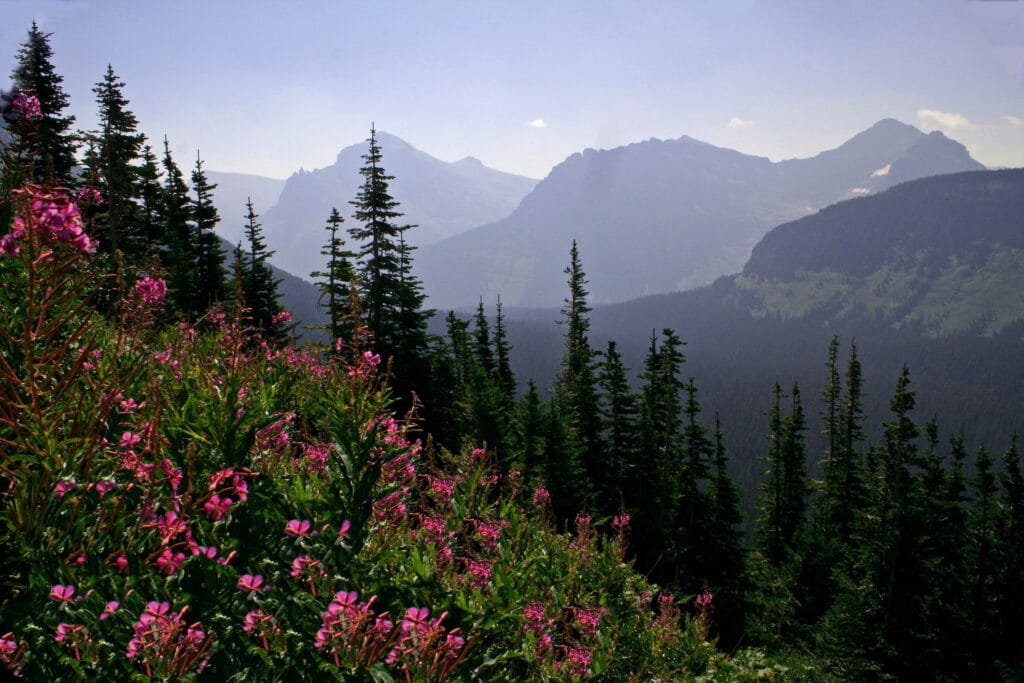
Glacier National Park’s entrance fee in 2025 is $35 per vehicle (valid for 7 days, covering all passengers), $30 per motorcycle, or $20 per individual on foot or bicycle. These rates drop by roughly $10 during winter (November 1 – April 30). An annual Glacier Park pass costs $70, and the US interagency “America the Beautiful” annual pass is $80 (covering all national parks). Children 15 and under enter for free, and there are special passes for seniors (62+), military families and veterans, 4th grade students, and visitors with disabilities that grant free or discounted entry.
The park is open 24 hours a day year-round, but many facilities operate only from late May through September due to weather. The alpine Going-to-the-Sun Road typically fully opens by late June and closes by mid-October as snow moves in.
In summer 2025, Glacier is piloting a ticketed entry: from 7 am to 3 pm, a free timed-entry reservation (in addition to the entrance pass) is required to drive the Going-to-the-Sun Road from West Glacier or to visit the remote North Fork area; similarly, Many Glacier Valley is restricting daytime vehicle access during July–September to those with shuttle or lodging reservations. Occasional wildfire activity in late summer can prompt temporary trail closures or campfire bans, but otherwise the major areas remain accessible. We visited on 25 July 2025, and all figures were valid then.
About the Glacier National Park
Established in 1910 as the United States’ 10th national park, Glacier protects over one million acres of Montana wilderness often nicknamed the Crown of the Continent.
What makes this park so unique? For one, its dramatic landscape was sculpted by ancient glaciers: dozens of long valleys, alpine cirques and emerald lakes were all carved by ice. Today only about two dozen glaciers remain in the high peaks (down from roughly 150 in the mid-19th century), and they’re sadly shrinking each year. Still, the legacy of ice has left a geologic wonderland of U-shaped valleys and knife-edged arêtes. We stood at Goose Island Overlook on St. Mary Lake, gazing at a scene worthy of a National Geographic cover – sharp peaks rising straight from the water, with wildflowers in the foreground – and felt humbled by the park’s raw beauty.
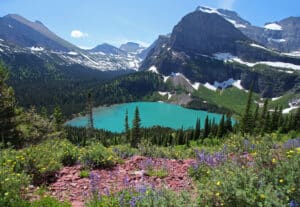
Glacier National Park in Montana
Glacier lies at a biological crossroads where prairie meets mountain. The park’s ecosystems range from lush cedar-hemlock rainforests on its western slopes to windswept grasslands on the east side. In between are alpine tundra and verdant valleys filled with spruce and fir. This diversity supports an impressive variety of wildlife.
We’ve watched bighorn sheep grazing on a sunlit hillside and spotted the park’s emblematic mountain goats effortlessly perch on cliff ledges. Grizzly and black bears roam widely here – in fact, Glacier is one of the few places in the continental US where all the major predators (bears, wolves, mountain lions, wolverines) still thrive in a complete, intact ecosystem. In quiet wetlands we even saw a moose cow and calf sloshing through the reeds at dusk.
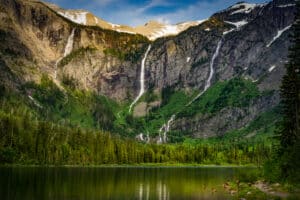
Avalanche Lake, Glacier National Park, Montana, USA.
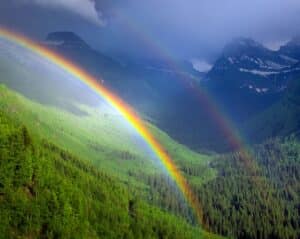
Double rainbow in Glacier National Park.
The park is also home to over 270 species of birds, from bald eagles to tiny hummingbirds. It’s no surprise this place was designated a UNESCO World Heritage Site (as part of Waterton-Glacier International Peace Park) in 1995 for its outstanding landscapes and biodiversity.
Beyond scenery and fauna, Glacier holds a lot of human and scientific history. Early conservationists like George Bird Grinnell dubbed it the “Crown of the Continent” and helped preserve it for future generations. We learned that park scientists today are studying everything from glacial melt rates to tree-line changes. One notable project involves restoring whitebark pine forests – a high-elevation pine species crucial for wildlife (and a favorite food of grizzlies) that is under threat from disease and climate change.
Park staff have been planting rust-resistant pine seedlings on burned mountain slopes to ensure these trees survive. Fire is a natural part of Glacier’s environment too: the park follows modern fire management policies, allowing some lightning-sparked fires to burn under supervision for ecosystem health. Still, big wildfires do occur. In 2017, for example, the Sprague Fire swept through the forest near Lake McDonald and even burned down the historic Sperry Chalet (a beloved 1914 stone lodge) – a stark reminder of nature’s power. Thankfully, an ambitious restoration project rebuilt the chalet by 2020, preserving a piece of the park’s heritage. Standing amidst these mountains, we could feel both the timelessness of the wilderness and the careful stewardship that keeps it wild.
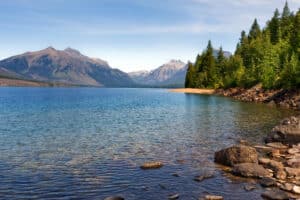
Lake McDonald, the largest lake in Glacier National park, Montana
Glacier is a paradise for hikers and adventurers, and most visitors spend at least a few days to soak it all in. There are 700+ miles of trails ranging from easy lake strolls to challenging peak climbs. We tackled a mix of both: one day might be a gentle walk through an old-growth forest to Avalanche Lake, and the next day a heart-pumping ascent to Grinnell Glacier overlook. The average traveler stays around three days here, but we could easily fill a week with new vistas daily – it was kinda impossible to experience everything in one go. For a better experience, we learned to adapt to the park’s rhythms. We recommend to start early each day – we spotted more wildlife at dawn, and later the crowds gets thick by midday on the popular trails. Afternoons often brought sudden thunderstorms rolling over the Divide, so having a flexible plan (and a rain jacket in our daypack) was essential. Whether you’re driving the epic Going-to-the-Sun Road or trekking into the backcountry, Glacier’s scale and variety reward those who take their time.
Nearby Sights and Food Options
-
Going-to-the-Sun Road & Logan Pass: This spectacular 50-mile alpine road is the park’s main artery and a must-do drive. We set out at sunrise from Lake McDonald, winding up to Logan Pass (6,646 ft / 2,026 m) as golden light hit the peaks. At the summit area, we found the Hidden Lake Overlook trailhead and hiked a short boardwalk through alpine meadows dotted with purple asters. A family of mountain goats calmly crossed right in front of us on the trail – a definite highlight! From the overlook, the view of Hidden Lake was jaw-dropping, framed by Bearhat Mountain. By mid-morning the parking lot was overflowing, so we were happy we arrived early. The road’s pullouts (like Wild Goose Island and Jackson Glacier Overlook) offered postcard scenes around every bend; we stopped often for photos.
-
Many Glacier Valley & Grinnell Glacier: Often called the Switzerland of North America, the Many Glacier area on the park’s east side was one of our favorite regions. We drove in at dawn past the historic Many Glacier Hotel, with Swiftcurrent Lake lying glassy and still. One morning, as we sipped coffee by the shore, we saw a moose wading across the misty lake shallows. Above loomed Mt. Grinnell and Mt. Gould, their snowy cirques glowing pink with first light. We hiked the Grinnell Glacier Trail – a strenuous all-day trek that climbs past three turquoise lakes and fields of beargrass. Partway up, a grizzly bear sighting on a distant slope gave us both a thrill and a reminder to keep our bear spray handy (park rangers drill this advice into you, and we were glad we’d listened!). The trail ended near the shrinking Grinnell Glacier itself, where icebergs floated in the milky blue glacier meltwater. Exhausted and happy, we returned to our car in the late afternoon, just as summer thunderstorms echoed in the peaks behind us.
-
Whitewater Rafting on the Flathead River (West Glacier): For a change of pace from hiking, we joined a half-day whitewater rafting trip just outside the park’s west entrance. The Middle Fork of the Flathead River forms Glacier’s southwestern boundary and offers fantastic rafting through wilderness canyons. After meeting our guides in West Glacier, we donned wetsuits and launched into the clear, chilly Flathead. The first stretch was gentle, letting us admire pine forests and rocky banks from the water. Soon, however, we entered John Stevens Canyon and the rapids began! We paddled through a series of Class II–III rapids with names like Tunnel, Bonecrusher, and Jaws, each one splashing cold glacial runoff all over us (to our laughing delight). Between rapids, we floated lazily and spotted a bald eagle soaring above the river. The views from the raft were unique – towering canyon walls and distant snowy summits that most park visitors never see from that angle. It was an adrenaline rush and a scenic float all in one. By the time we pulled out near West Glacier, we were thoroughly soaked and grinning ear to ear. If you’re visiting in summer, we highly recommend trying a rafting adventure – it was one of the most memorable things we did.
-
Local Flavors & Relaxation: After long days of exploring, we made sure to sample the local food and recharge. In Apgar Village at the west end of the park, we dined at Eddie’s Cafe – a rustic, family-run spot known for hearty comfort food. The huckleberry bear claws we had for breakfast there were the perfect sweet start before a big hike, and later we returned for a Montana bison burger with huckleberry BBQ sauce (when in Montana, right?). On the east side, we stopped at the Park Cafe in St. Mary specifically to try their famous pies. One slice of warm huckleberry pie à la mode, and we understood why there was a line out the door – it was simply delicious, packed with wild berry flavor. We also loved browsing the gift shops in the small gateway towns. In West Glacier, we picked up some locally made huckleberry jam and a Christmas ornament carved from native wood. Meanwhile, at a shop near St. Mary, we admired Blackfeet beadwork and purchased a small handmade bracelet as a meaningful souvenir. These little stops gave us a nice break from the trail and a chance to chat with friendly locals.
By the end of our trip, we were happily exhausted and filled with fresh mountain air. Glacier National Park had offered us a rare mix of adventure, learning, and serenity. We came for the famous views and epic trails, but we left remembering the quiet moments too – like watching the sunset paint the sky over Lake McDonald on our final evening. In the gathering dusk, loons called across the water and we felt a deep sense of peace. Glacier’s wild magic had worked its way into our hearts. We drove away already dreaming of our next journey here.
Sorry, there were no items that matched your criteria.

